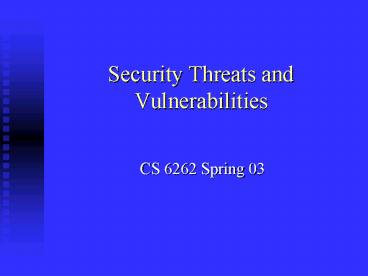Security Threats and Vulnerabilities - PowerPoint PPT Presentation
1 / 19
Title:
Security Threats and Vulnerabilities
Description:
Dr. Wenke Lee. Georgia Tech. To: William Smith. M.I.B. Corp. ... Other DoS attacks are still possible (e.g., TCP SYN-flood) IP Spoofing & SYN Flood ... – PowerPoint PPT presentation
Number of Views:2908
Avg rating:3.0/5.0
Title: Security Threats and Vulnerabilities
1
Security Threats and Vulnerabilities
- CS 6262 Spring 03
2
The Security Life-Cycle
- Threats
- Policy
- Specification
- Design
- Implementation
- Operation and Maintenance
3
Taxonomy of Threats
- Taxonomy a way to classify and refer to threats
(and attacks) by names/categories - Benefits avoid confusion
- Focus/coordinate development efforts of security
mechanisms - No standard yet
- One possibility by results/intentions first,
then by techniques, then further by targets, etc. - Associate severity/cost to each threat
4
A Taxonomy Example
- By results then by (high-level) techniques
- Illegal root
- Remote, e.g., buffer-overflow a daemon
- Local, e.g., buffer-overflow a root program
- Illegal user
- Single, e.g., guess password
- Multiple, e.g., via previously installed
back-door - Denial-of-Service
- Crashing, e.g., teardrop, ping-of-death, land
- Resource consumption, e.g., syn-flood
- Probe
- Simple, e.g., fast/regular port-scan
- Stealth, e.g., slow/random port-scan
5
Threat Examples - IP Spoofing
- A common first step to many threats.
- Source IP address cannot be trusted!
SRC source DST destination
IP Payload
IP Header
SRC 128.59.10.8 DST 130.207.7.237
Is it really from Columbia University?
6
Similar to US Mail (or E-mail)
US mail maybe better in the sense that there is a
stamp put on the envelope at the location (e.g.,
town) of collection...
7
Most Routers Only Care About Destination Address
src128.59.10.8 dst130.207.7.237
128.59.10.xx
Rtr
Columbia
130.207.xx.xx
Rtr
Georgia Tech
36.190.0.xx
Rtr
src128.59.10.8 dst130.207.7.237
Stanford
8
Why Should I Care?
- Attack packets with spoofed IP address help hide
the attacking source. - A smurf attack launched with your host IP address
could bring your host and network to their knees. - Higher protocol layers (e.g., TCP) help to
protect applications from direct harm, but not
enough.
9
Current IPv4 Infrastructure
- No authentication for the source
- Various approaches exist to address the problem
- Router/firewall filtering
- TCP handshake
10
Router Filtering
- Decide whether this packet, with certain source
IP address, should come from this side of
network. - Not standard - local policy.
Hey, you shouldnt be here!
Rtr
36.190.0.xx
src128.59.10.8 dst130.207.7.237
Stanford
11
Router Filtering
- Very effective for some networks (ISP should
always do that!) - At least be sure that this packet is from some
particular subnet - Problems
- Hard to handle frequent add/delete hosts/subnets
or mobileIP - Upsets customers should legitimate packets get
discarded - Need to trust other routers
12
TCP Handshake
server
client
SYN seqx
SYN seqy, ACK x1
ACK y1
connection established
13
TCP Handshake
seqy, ACK x1
128.59.10.xx
Rtr
Columbia
130.207.xx.xx
Rtr
Georgia Tech
36.190.0.xx
Rtr
x
The handshake prevents the attacker from
establishing a TCP connection pretending to be
128.59.10.8
src128.59.10.8 dst130.207.7.237
Stanford
14
TCP Handshake
- Very effective for stopping most such attacks
- Problems
- The attacker can succeed if y can be predicted
- Other DoS attacks are still possible (e.g., TCP
SYN-flood)
15
IP Spoofing SYN Flood
- X establishes a TCP connection with B assuming
As IP address
(4) SYN(seqn)ACK(seqm1)
A
B
(2) predict Bs TCP seq. behavior
SYN(seqm),srcA
(1) SYN Flood
(3)
(5) ACK(seqn1)
X
16
ping
smurf
17
Smurf Attack
- Generate ping stream (ICMP echo request) to a
network broadcast address with a spoofed source
IP set to a victim host - Every host on the ping target network will
generate a ping reply (ICMP echo reply) stream,
all towards the victim host - Amplified ping reply stream can easily overwhelm
the victims network connection - Fraggle and Pingpong exploit UDP in a similar way
18
Vulnerability
- A vulnerability (or security flaw) is a specific
failure of the security controls. - Using the failure to violate the site security
exploiting the vulnerability the person who does
this an attacker. - It can be due to
- Lapses in design, implementation, and operation
procedures. - Even security algorithms/systems are not immune!
- We will go over some examples in this course.
19
Example IP Protocol-related Vulnerabilities
- Authentication based on IP source address
- But no effective mechanisms against IP spoofing
- Consequences (possible exploits)
- Denial of Service attacks on infrastructures,
e.g. - IP Spoofing and SYN Flood
- Smurf and Fraggle attacks
- OSPF Max Sequence

